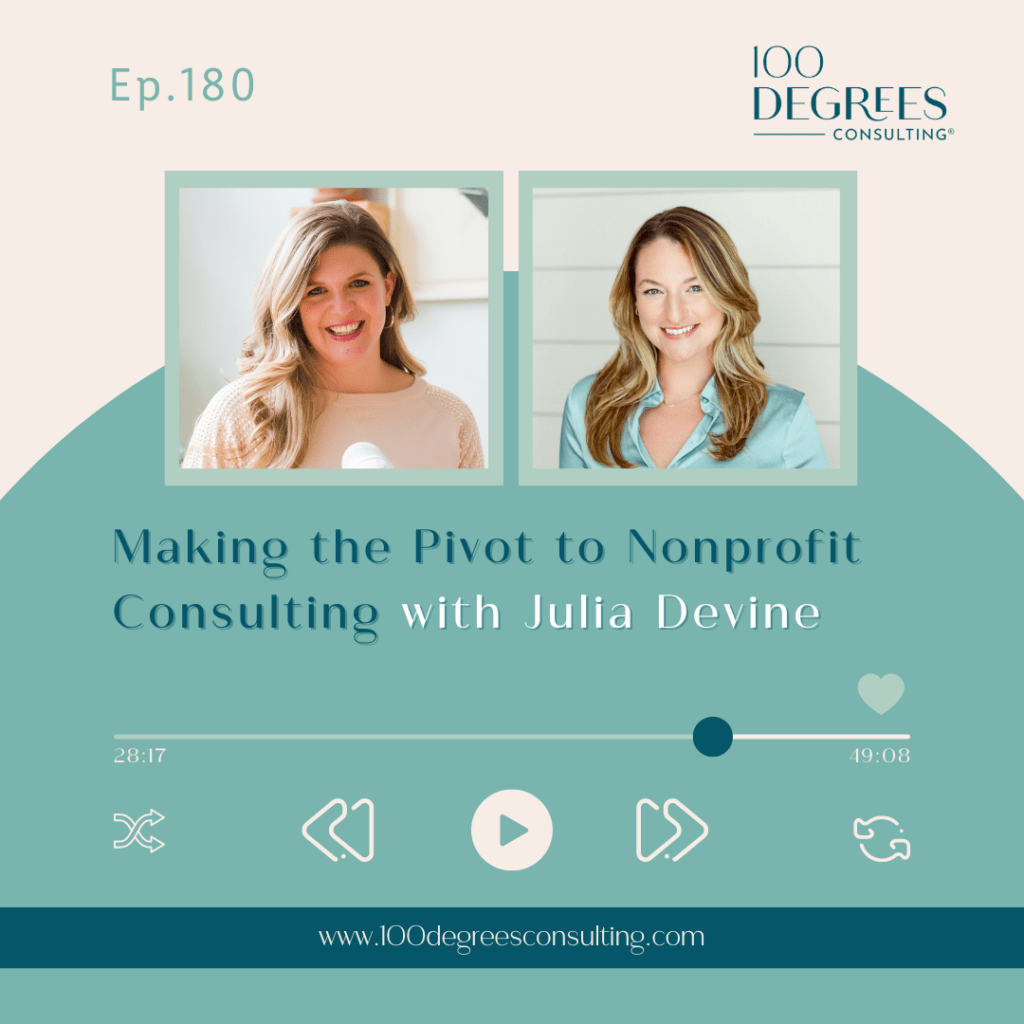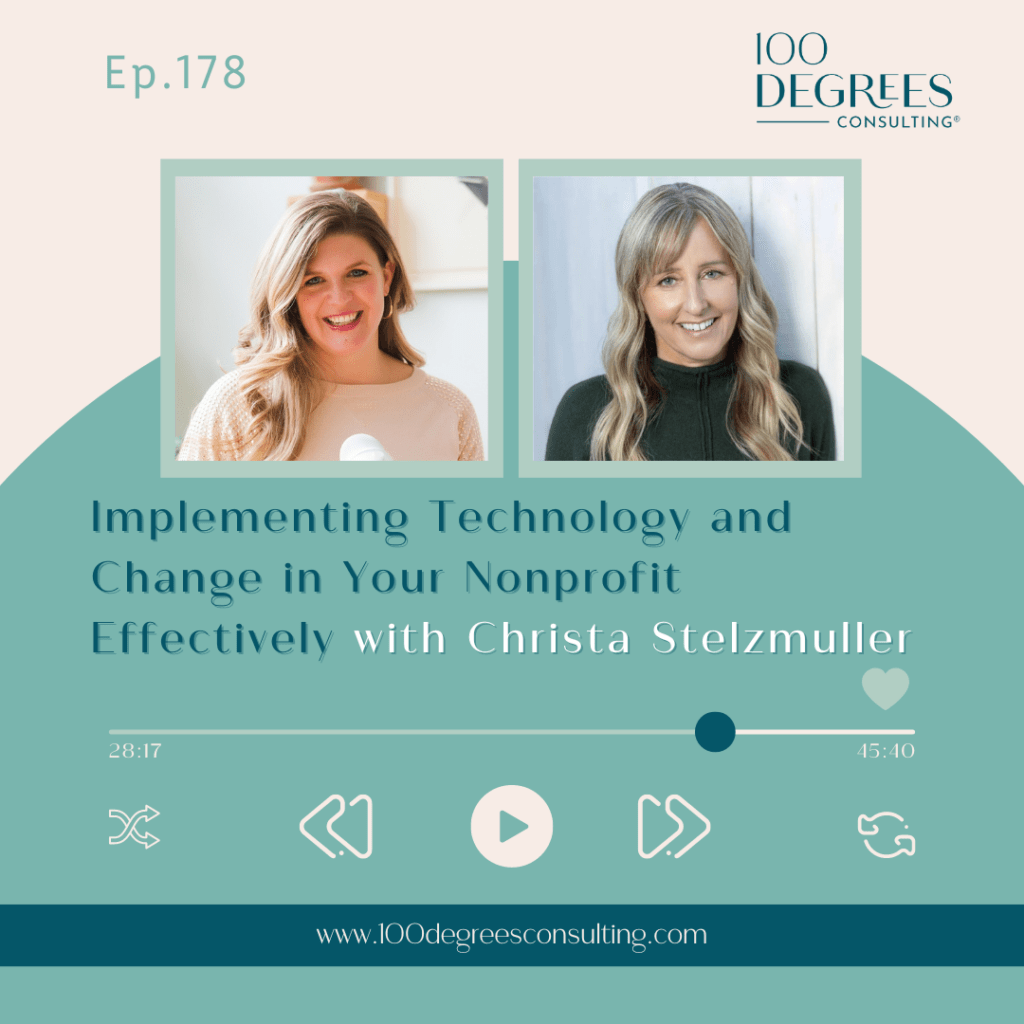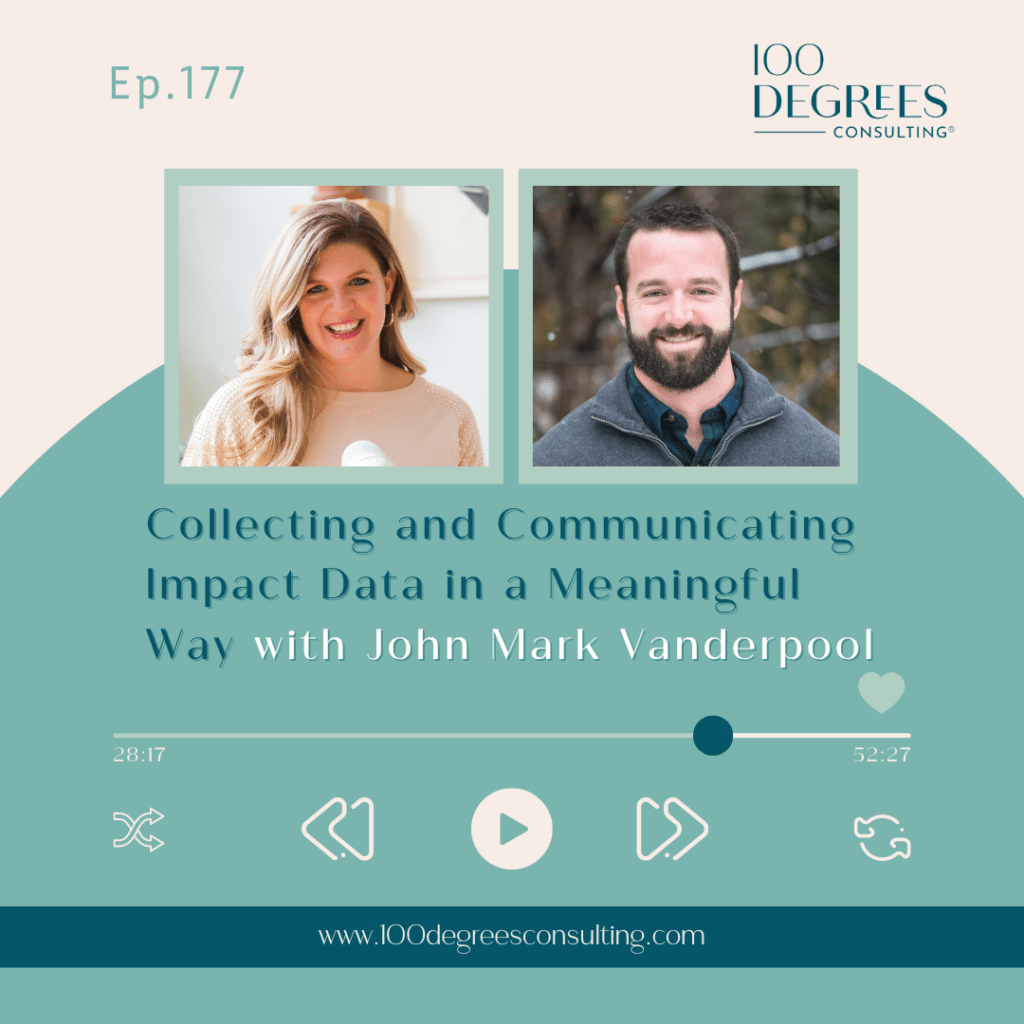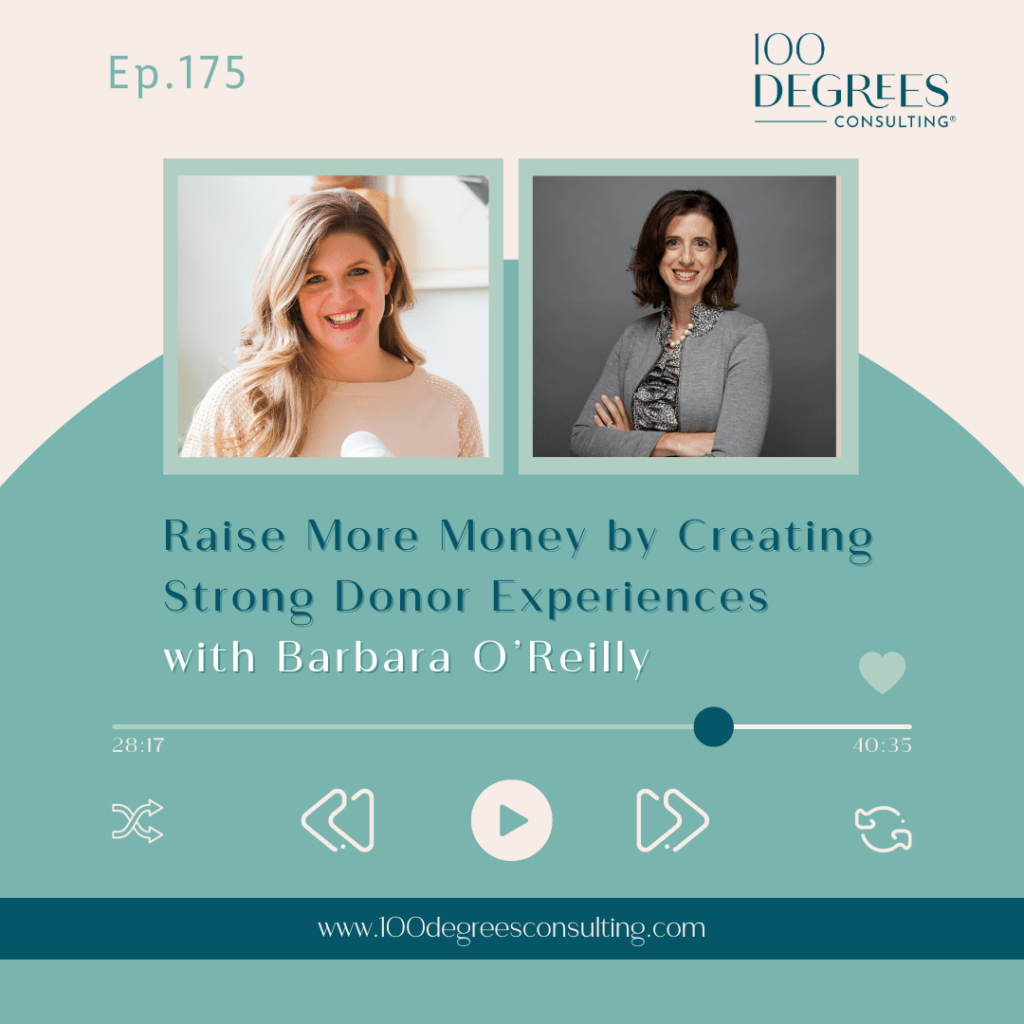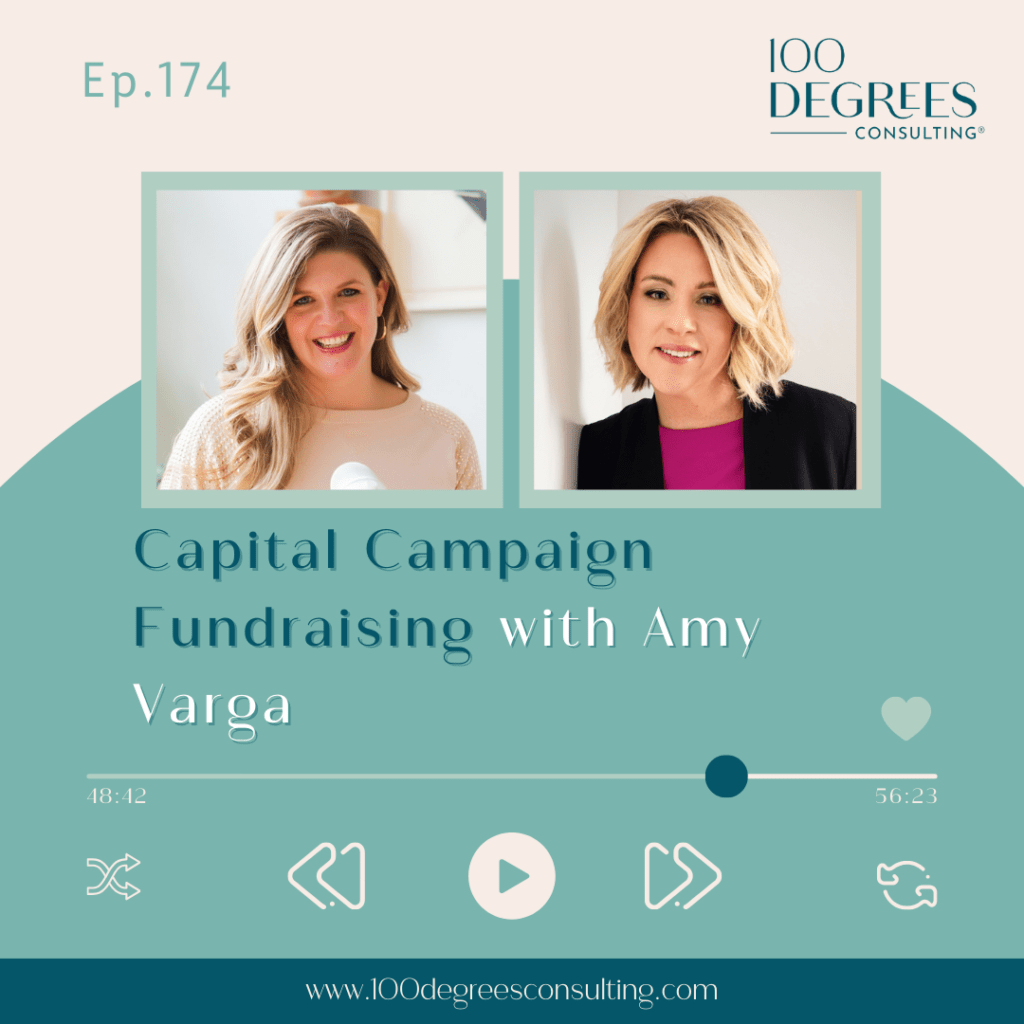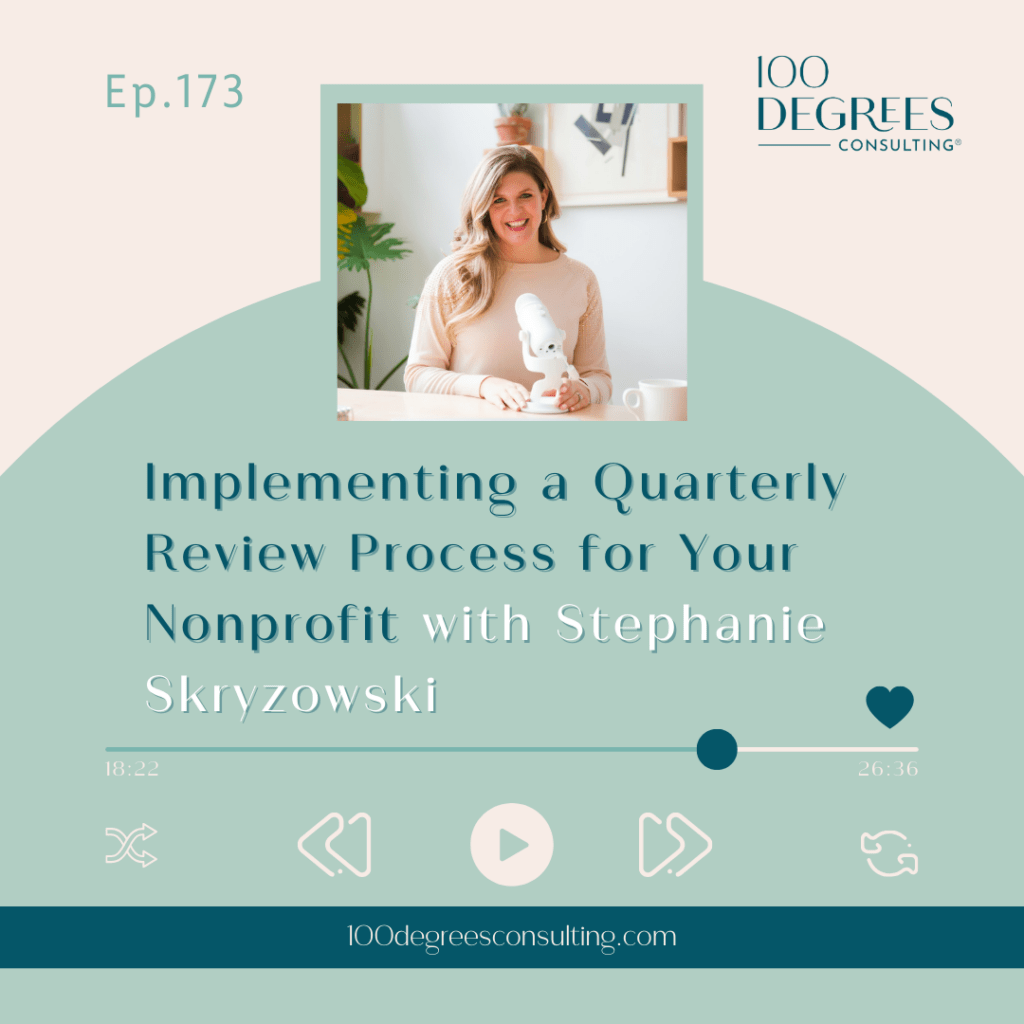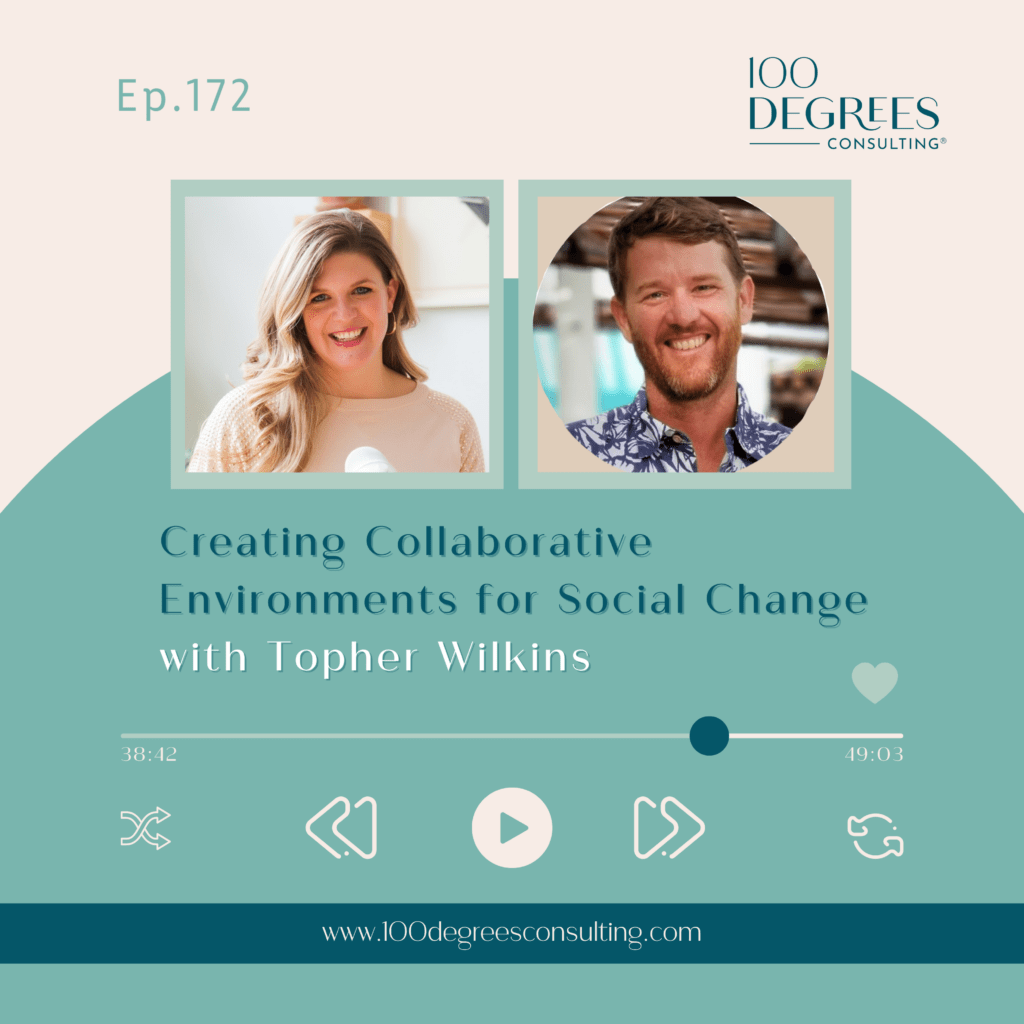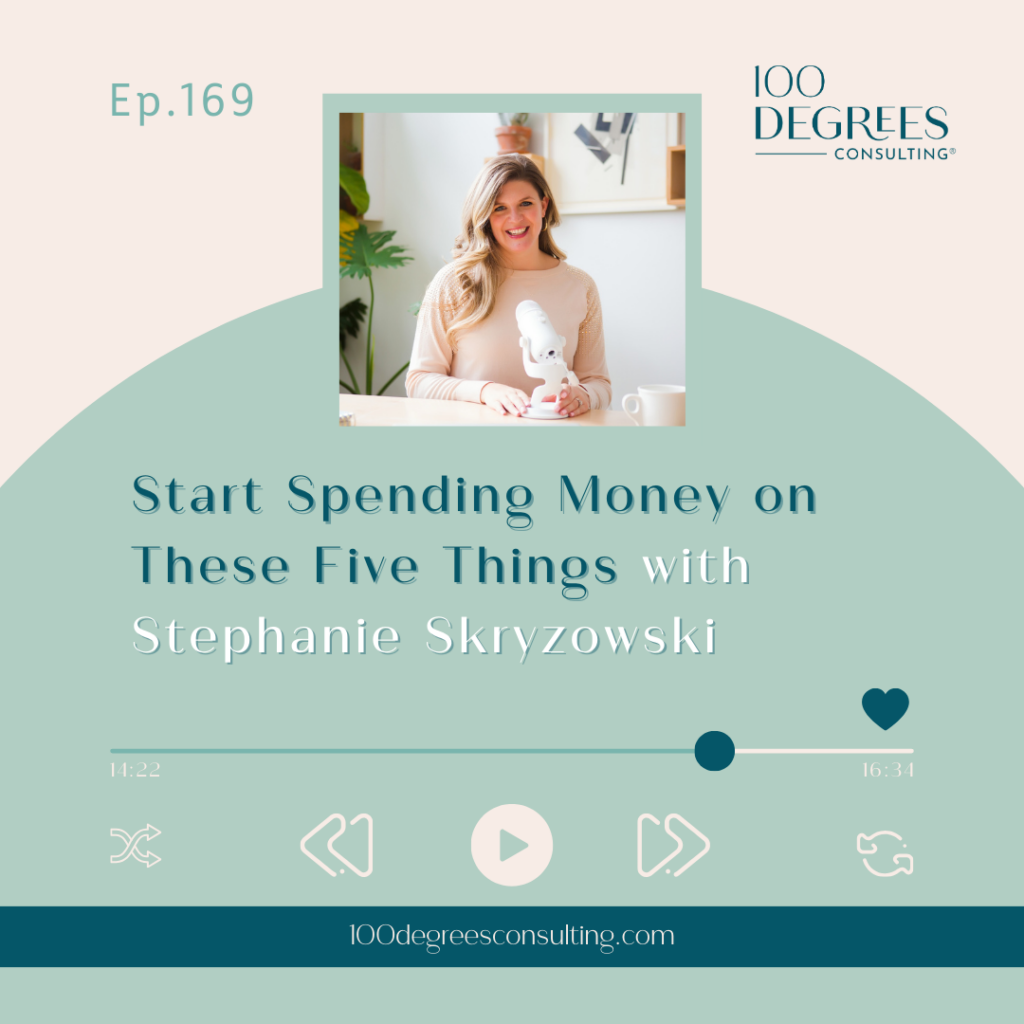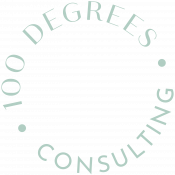Transcript Episode 113 – Investing in Yourself as a Nonprofit Leader on The Prosperous Nonprofit
[00:00:00] Stephanie Skryzowski: Hey there. If you’re looking for the 100 degrees of entrepreneurship podcast, you’re in the right place after a hundred amazing episodes, we’re changing things up to serve you the most inspiring content in a fresh new way. Thanks for being here and keep listening.Welcome to the prosperous nonprofit, the podcast for leaders who are building financially sustainable and impactful nonprofits and changing the world. I’m Stephanie Kowski, a Chief Financial Officer and founder and c e O of 100 Degrees Consulting. My personal mission is to empower leaders to better understand their numbers.
To grow their impact and their income. On this show, we talk to people who are leading the nonprofit sector in new, innovative, disruptive, and entrepreneurial ways, creating organizations that fuel their lives, their hearts, and their communities. Let’s dive in.[00:01:00]
Hey everybody. Welcome back to this show. It’s me, Stephanie, and I have a solo episode for you today talking about one of my favorite subjects. We are talking about investing in. Yourself. Now, if I were to ask you to raise your hand, if you have invested in yourself, in your own professional or personal development in the last six months, would you be raising your hands?
What about the last year? What about the last two years? So you may still not be raising your hand, right? Because I know that as a leader in the nonprofit sector, you have a lot going on, right? You are juggling team and board and donors and programs and deadlines and applications, and you’re juggling a lot.
And resources might be kind [00:02:00] of tight and so, This is the case. I feel like as a mom too, I like often am prioritizing everybody else. And then I come last like, let’s make sure my kids have everything that they need and they’re taken care of. Let’s make sure my husband’s taken care of and let’s make sure the dog is fed and he’s taken care of.
And then, yeah, okay, maybe I’ll sit down to eat too. Right? And so as a nonprofit leader, I feel like this happens all the time where we just don’t prioritize ourself, but. That is not going to help us bring our best selves to the table as a leader. Right? And in my business, this is something I actually learned kind of early, actually, really early, because I in fact, invested in a business coach.
Like before I kind of had a business, so I had this idea that I was kicking around while I was also stuck in what I really felt like was an unfulfilling and dead end job. For [00:03:00] me, it was just, it was not the right job for me and I felt really stuck. I wanted to start my family, but that wasn’t working either, and I wasn’t happy in my career and I just felt.
In a really tough place, and I had this business idea and so I hired a business coach and it was a big investment for me at the time because I was needing to tap into my salary to pay for this business coach. There was no, you know, no employer to pay for it for me, and I did it. I made the leap, I felt really connected to her.
I thought that she could help me, so I hired her as my business coach and I’ve never looked back since, honestly, and over the years, I have spent, when you add it up, probably hundreds of thousands of dollars. Honestly, probably hundreds of thousands of dollars on myself and my own personal growth and professional development, and.
It has been [00:04:00] so worth it. So ever since that initial business coach, I have joined different masterminds, which is like a group of other similar people kind of in my space, other entrepreneurs that are at the same level that I am with different business coaches. And I’m in one right now, and I have a business coach right now, Rachel Rogers, who’s fantastic.
And. This has helped me so much. I can’t even like begin to explain all the ways that this has helped me, but a few things. I mean, I have so much more confidence now because I have gone through a lot and I’ve learned lessons along the way that have helped me gain confidence. To, you know, reach new heights in my business, right?
I have like a group of people, or when I was working with a one-on-one business coach, I have like somebody to bounce ideas off of often. I know the nonprofit sector and entrepreneurship is often very lonely. I don’t, uh, [00:05:00] I, you know, I, I have had times when I haven’t felt like I had a group of people or anybody that I could really.
Talk to or troubleshoot problems with. And so investing in myself, in these business coaches, in these masterminds has given me that ability and really helped me make better decisions. Investing in myself has also given me a better work-life balance. Not only have I. Had somebody to just sort of hold me accountable.
Right. I remember one of my first meetings with the woman that’s my business coach now, Rachel Rogers, one of our very first meetings, like a year over a year ago. She was like, what do you do for yourself or for fun? And most of the people in the mastermind literally couldn’t think of anything. And she’s like, okay, no.
Like this is not okay. We need to think of something that we want to do that we have fun doing and we need to do it right. And so I think, think about yourself as a nonprofit leader. When is the last time you had fun and like did something for [00:06:00] yourself, invested in your. In your personal growth in that way.
And so having that sort of accountability to, you know, go out and do something fun, really sort of broader, have a better work life balance, has been a game changer. Which by the way, my fun thing that I’ve been doing is watercolor painting. That’s something I’m really getting into and having a lot of fun with.
So, Anyway, investing in yourself as a leader can really help you not only like develop new skills and knowledge, but really enhance your confidence, your decision making abilities, help you level up in a way that frankly you cannot do on your own. And it’s just gonna make you happier. And I can say that from experience because, I have done this myself.
In fact, in episode 13 of this podcast, I give you a behind the scenes in how I spend money in my business, and so I share the details. At that time, it was May of 2021 when that episode came out exactly how I spend money in my [00:07:00] business, and one of the biggest line items of expenses is investments in myself.
So again, I just don’t see this happening in the nonprofit sector often. Enough. We are not investing in ourselves. We’re putting everybody else first. But the only way that you’re really going to show up to the table, show up to your desk, show up to your work every single day as your best self, as the most you know, productive and prosperous leader that you absolutely can be is if you are taking the time to invest Now.
What does that actually mean though? Do you need a one-on-one business coach or you know, maybe a fundraising coach or an executive leadership coach? Maybe that’s something, maybe it’s a mastermind, a group of other like-minded leaders who are kind of at the same level as you. I know that’s been wildly helpful for me because I have been able to really see how other people who are running [00:08:00] businesses similar to mine do things, right?
It’s not something that you can just Google, and so if you found a peer group, that might be something to invest in. And you know what? Sometimes you have to pay for those. One quick note on that. Um, can you have a peer group for free? Can you be part of, you know, just like get a bunch of people together that you know, and have that peer group for free?
100% You can. However, in my experience, people don’t take things as seriously that they don’t like put some financial investment in, right? So if you pay, you know, a thousand, 5,000, $10,000 for. A leadership development group or an executive leadership coach, like you’re gonna show up and do those meetings.
You are going to get your money’s worth. You’re going to ask questions, you’re gonna do the homework, you’re going to do everything that you need to do. Whereas if you didn’t pay anything for it, it’s a lot easier to just, ugh, okay, delete this meeting off the calendar. I need to do something else. Or, well, I’m not really gonna do the homework.
You [00:09:00] know, it just, I don’t, I just don’t have time this week. Right. But when you have made a financial investment in something, you are much more likely to stick with it. So, Just a little note that while yes, you absolutely can have a peer group, it is also wildly valuable to have one that is paid.
Have you been spinning your wheels trying to figure out how some nonprofits have three or six months of a cash reserve while you’re barely scraping by to make payroll every two weeks? I’d venture to guess that one of the reasons you feel overwhelmed and nervous about your cash situation is because you don’t have a forecast.
So I’ve created a free cash forecast template for you. This spreadsheet will help you forecast your cash flow, build an insightful budget, and really help you see into the future of your revenue and expenses. I’ve built the template for you now. All you have to do is use it, gain more clarity into your numbers.
You can make smart decisions [00:10:00] today to grow your impact and income tomorrow. Head over to 100 degrees consulting.com/cash to get your free spreadsheet
A. Okay, so you can hire a coach, you can have a Mastermind or join a Mastermind. You can attend conferences and workshops. And you know, one thing that I think. It’s really smart about conferences and workshops is really thinking strategically about like, okay, what is my goal? What do I need to take away?
Am I looking to, maybe you’re looking to network with your peers and you’re looking to walk away with maybe a new. Peer Mastermind, right? A group of peers that you can connect with. Maybe that’s your goal. Maybe your goal is to connect with people in different areas that you could potentially partner with, right?
So just because there’s a big conference or there’s a conference in your city, or this is a conference that your organization has always shown up at every single year. Really think strategically, right? [00:11:00] Because we are most likely not working with an unlimited budget. So rather than going to the conferences in your city just because like, well, it’s here and it’s convenient, think strategically about what your goals are and how this conference or this workshop can.
Help you get what you need. And one other thing I will add, and something I personally have learned is that if my goal, if my personal goal is to network and to build connections in any, you know, particular area, I probably don’t wanna go to a conference, to be honest. I want to go to a workshop, some sort of more intimate setting because a conference with 800,000, 2000 people, I’m gonna have a hard time.
Forging those deep connections that are meaningful to me that I really wanna forge. Where if I’m in a workshop with maybe 50 or a hundred people, I know personally that I am much more likely to go up to somebody to sit down next to someone and start chatting with them. So anyway, just some food for thought to really not just do what you’ve always done, [00:12:00] but really think strategically about how are you gonna get the most out of this investment.
The other thing that I think is sort of newly widely available is online courses. So if there’s a particular area of your work that you really want to get stronger in, Taking an online course is an amazing option, right? I feel like if we were to go back maybe 10 years ago, there were not all these online courses, right?
You would’ve had to go to a university or go to a professional association or go to, you know, some sort of community center. Locally in order to take this course. But there are so many good online courses and training programs that you can take to, you know, really enhance your skills, enhance your expertise in one particular area.
You know, I know several people that have grant writing courses, so if you’re like, man, we really need to uplevel our grant writing, that is something you can very [00:13:00] easily. Do online, and most of these courses are self-paced. Most of them involve, you know, some sort of live coaching or you know, live q and a with the person that created them.
You know, we have a course master your nonprofit numbers and if you wanna like, Brush up on your nonprofit financial management. Same thing. It’s a self-paced online course that you can take on your own time and get some support along the way as well. So think about again, if there’s something specific and maybe technical and tactical that you want to learn.
There’s probably an online course for it, and we just, you know, we need to get creative because I feel like nobody, In your organization is going to come up to you and hand you this beautiful document, and of all of these ways that you can invest in yourself, right? They’re not going to say, here’s your list of investments.
Why don’t you choose? And then we will hand it to you on a platter, right? You need to take initiative for yourself and figure out, okay, what are my goals? [00:14:00] What is standing in the way? Between me today and me achieving that goal, and let’s fill in some investments in myself to help me get there. Right? So I believe that this is on us.
This is a. Commitment that we need to make to ourselves to continuously seek out new opportunities for growth and development, because I think this is what is going to help you become a more successful leader. I think this is what’s gonna help you get out of your own way, to be honest with you. So let me tell you a little story here.
A couple years ago, I had hired a, an operations coach, so she was a business coach and she was really focused on the operations of the business. And at that point we had like a bunch of team members. We had a lot of clients, but we had never really spent a lot of time on the backend operations of, of the business, our systems and things like that.[00:15:00]
And so she was kind of asking me my goals for, I guess, probably the year, um, or maybe my bigger goals for, I think it was my bigger goals for the business. I was like, well, I think once we hit like a million dollars in revenue, we’ll probably have to just like kind of tap out there. I don’t think I’ll be able to grow more than that.
And she’s like, Uh, why not? I’m like, well, cuz that means we’d have to have like maybe 15 employees and like, how am I supposed to manage 15 employees? I don’t wanna manage 15 employees. And she’s like, I. Okay. That’s when you hire a director of operations and that’s when you hire this role, and that’s when you hire that role.
And, um, you know, this is the org chart, this is how it would look, and this is what the, you know, sort of management structure would look like. She’s like, you would not be supervising 15 employees. Are you crazy? I. So my point is she helped me like totally smashed through that invisible ceiling that I had placed on myself.
I had said, I’ll, there’s no way my business will ever be able to generate more [00:16:00] than a million dollars cuz I don’t wanna manage that many people. And she’s like, yeah, no. And so. That is what’s possible. And so now I’m like, oh my gosh, this business could grow infinitely, right? We bring on new clients, we add new team, we add new structures to the back end of our business, and we could just keep growing forever, right?
So you may think about this. You may be putting some sort of invisible barriers, invisible limits on the impact that your organization could have, because you only know what you can see, right? And so there may be some barriers and some upper limits that you have. Placed on yourself unknowingly, and by digging deeper into your own professional development, into your own personal development, working on your mindset, working on your confidence by, you know, either learning some new skills or working with a coach or being in a peer group.[00:17:00]
Like imagine what is possible. Like I could never have imagined when I started first working with that business coach, like almost. I don’t know, seven years ago at this point, I never would’ve imagined that my business is what it is today. And so if you think about the impact that your organization already has, imagine what it could be.
If you strategically invest in yourself as a leader. So I hope this convinced you, I hope this convinced you how important it is to invest in yourself, invest in the other leaders in your organization, right? Because if we, maybe we need to get our C o O, maybe they need a coach so we can help them continue to elevate and continue to grow.
Like when we think about succession planning. With the leadership of our organization, how can we continue to invest in the team so that they can grow and evolve and, you know, add to their skillset as well. So this is something that absolutely needs to be built into your [00:18:00] budget every single year. To me, this is not an extra, this is not a like, oh, if we.
Have money. Maybe we’ll invest in ourselves. Maybe we’ll invest in the team. No, this is a non-negotiable. Now, I’m not saying this needs to be, you know, like 30% of your entire budget or anything, but this is important because the only way that we can have the impact on the outside is if we’re taking care of the inside.
For taking care of the people on the inside. So add it to your budget. This is super important and I hope, I hope I’ve convinced you. I will say investing in myself has been an absolute game changer, and this is not something that I feel like I was really accustomed to. This isn’t like, Part of what I’ve always done right?
It started with this business coach because I felt so stuck in my life and then I realized the benefit, and I have always had a business coach or a mastermind ever since, and it’s been a game changer for me. So my friends, I hope this was helpful. Like I [00:19:00] said, listen to go back and listen to episode 13 if you wanna see how I spend money in my business and exactly how, how much, like what percentage of my expenses have gone towards investment like this.
Um, cuz I’m pretty sure it’s pretty big, super important. Anyway, I hope this was helpful to all a few non-profit leaders and I think this is one key to running a prosperous. Nonprofit. So I will see you next time. Before you go, I just wanna thank you for being here. To access our show notes and bonus content, visit 100 degrees podcast.com.
That’s 100 degrees podcast.com, and I’ll see you next time.


